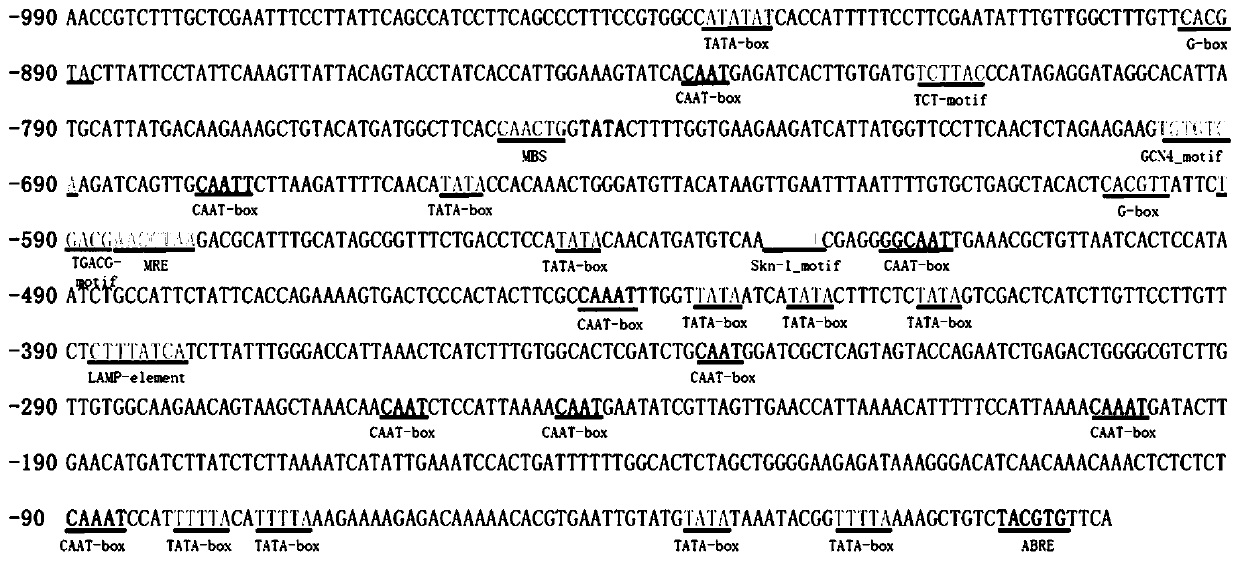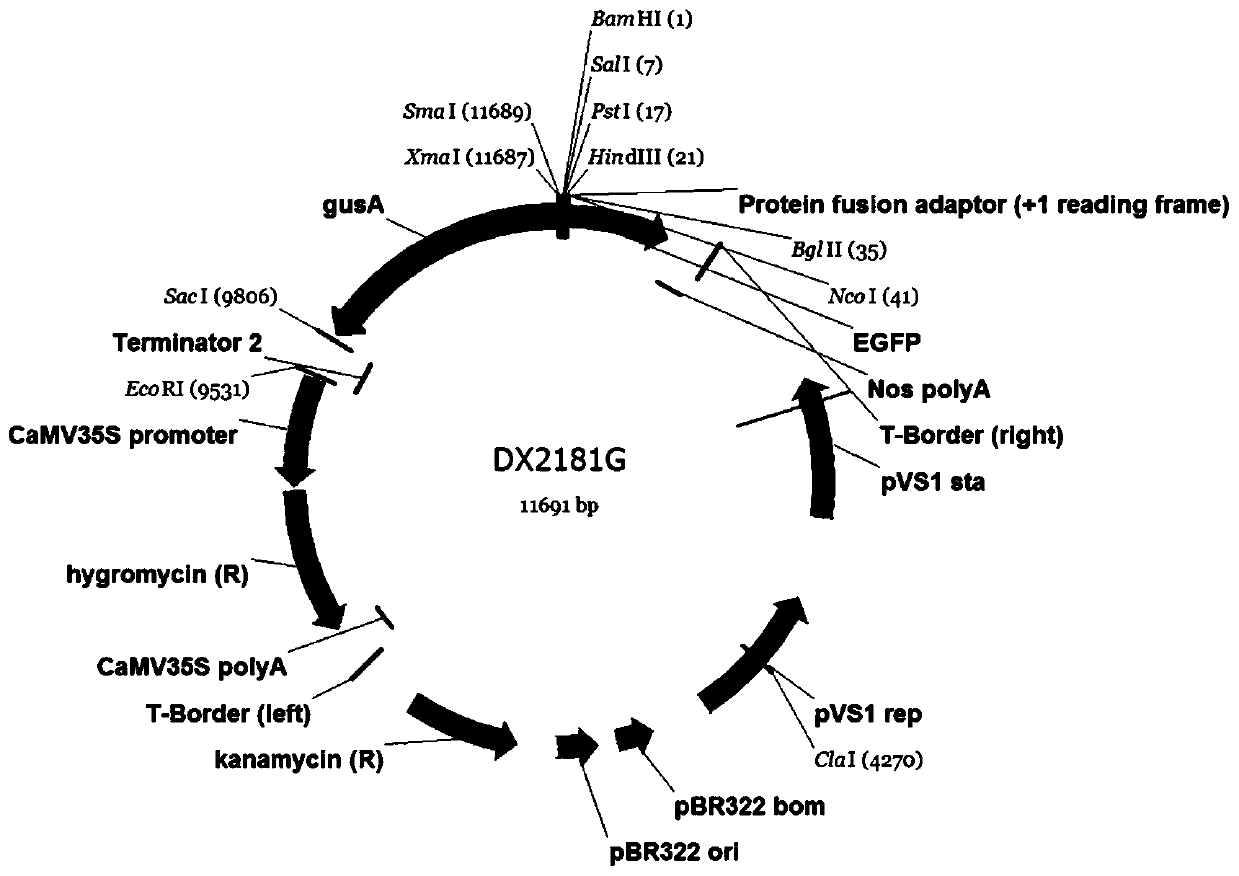Brassica napus embryo-specific promoter pbnaa09g21960d and its application
A pbnaa09g21960d, promoter technology, applied in the field of plant genetic engineering and biology, can solve problems such as unsuitable production practice, unfavorable normal plant growth, and harmful ecological environment
- Summary
- Abstract
- Description
- Claims
- Application Information
AI Technical Summary
Problems solved by technology
Method used
Image
Examples
Embodiment 1
[0034] Embodiment 1: The primer sequence design of rapeseed promoter pBnaA09g21960D:
[0035] According to the BnaA09g21960D gene (Sequence ID: XM_009109941.1) upstream gene spacer sequence 990bp obtained by rapeseed genome sequencing, a pair of primers were designed for PCR amplification, and the 5' upstream promoter sequence of rapeseed BnaA09g21960D was amplified, and the primers used were pBnaA09g21960D- F: 5′-GAGATCTACAGCGCTAAGCTTaaccgtctttgctcgaatttc-3′ and pBnaA09g21960D-R: 5′-GGACTGACCACCCGGGGATCCtgaacacgtagacagcttttaa-3′. In the primer pBnaA09g21960D-F, the sequence GAGATCTACAGCGCT is the upstream sequence of the fusion site of the vector DX2181, and the sequence AAGCTT is the restriction site of Hind III; in the primer pBnaA09g21960D-R, the sequence GGACTGACCACCCGG is the downstream sequence of the fusion site of the vector DX2181, and the sequence is GGATCC Restriction site for BamH I.
Embodiment 2
[0036] Example 2: Preparation of rapeseed promoter pBnaA09g21960D:
[0037] Rapeseed used in the present invention is Brassica napus L. Darmor (provided by researcher Liu Shengyi, Institute of Oil Crops, Chinese Academy of Agricultural Sciences, hereinafter the same), and rapeseed is sown in the field and managed in the normal field. Genomic DNA of rapeseed leaves was extracted by CTAB method, and polymerase chain reaction PCR (Polymerase chain reaction) was carried out using the extracted whole genome DNA of rapeseed as a template. PCR system: 2×Mix buffer 25 μL, pBnaA09g21960D-F: 1 μL, pBnaA09g21960D-R: 1 μL, DNA 1 μL, ddH 2 O 22 μL. The PCR program was: 94°C for 5 min; 35 cycles of 94°C for 30 s, 56°C for 30 s, and 72°C for 1 min; 72°C for 10 min; 4°C∞. The PCR product size is 990bp (see figure 1 ), identified by 1.0% agarose gel electrophoresis, purified and recovered, and tested for concentration according to the instructions of the kit.
[0038] The DX2181 vector pla...
Embodiment 3
[0039] Example 3: Sequence Analysis and Function Prediction of Rapeseed Promoter pBnaA09g21960D:
[0040]The pBnaA09g21960D sequence obtained by cloning and sequencing was used in PlantCARE (Lescot M, Déhais P, Thijs G, et al. PlantCARE, a database of plantcis-acting regulatory elements and a portal to tools for in silico analysis of promoter sequences [J]. Nucleic acids research, 2002, 30 (1): 325-327. http: / / bioinformatics.psb.ugent.be / webtools / plantcare / html / ) online predictive analysis of functional components. The results show that if figure 2 As shown, pBnaA09g21960D contains core elements TATA box and CAAT box necessary for eukaryotic promoters. Further analysis of the promoter sequence found that in addition to the necessary core elements, there are also a variety of promoter functional elements in the pBnaA09g21960D sequence: ABRE (TACGTG): cis-acting element involved in the abscisic acid responsiveness, abscisic acid responsive cis-acting element ; G-Box(CACGTA / CA...
PUM
 Login to View More
Login to View More Abstract
Description
Claims
Application Information
 Login to View More
Login to View More - R&D
- Intellectual Property
- Life Sciences
- Materials
- Tech Scout
- Unparalleled Data Quality
- Higher Quality Content
- 60% Fewer Hallucinations
Browse by: Latest US Patents, China's latest patents, Technical Efficacy Thesaurus, Application Domain, Technology Topic, Popular Technical Reports.
© 2025 PatSnap. All rights reserved.Legal|Privacy policy|Modern Slavery Act Transparency Statement|Sitemap|About US| Contact US: help@patsnap.com



